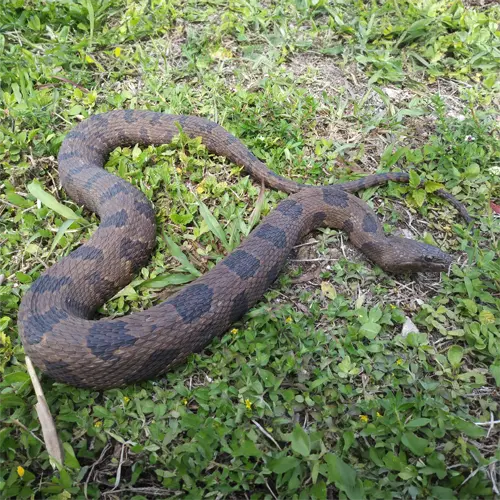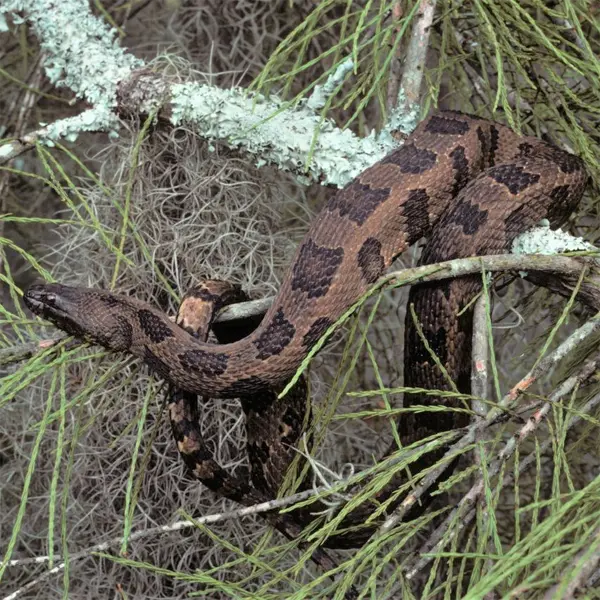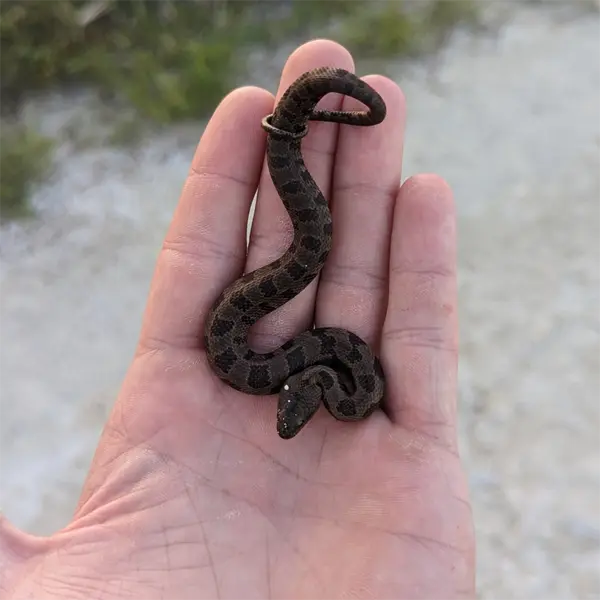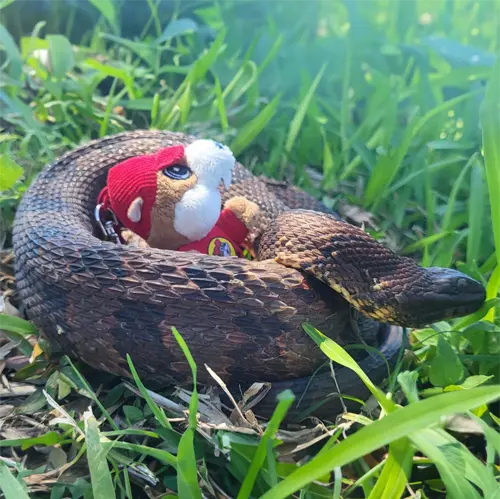Brown Water Snakes in Central Florida
The brown water snake (Nerodia taxispilota) is a non-venomous colubrid species found throughout the southeastern United States. As their name suggests, brown water snakes thrive in aquatic environments like the wetlands, swamps, and rivers of central Florida.
This guide provides identification tips, biology facts, and information on brown water snake habits, diet, reproduction, health risks, and prevention methods if encountered near residential areas.
Appearance and Identification
Brown water snakes can be identified by the following juvenile and adult characteristics
Brown water snakes can be confused with some harmless watersnakes like the banded water snake and red-bellied water snake, which have more defined markings. Venomous cottonmouths have a much heavier build and prominent facial pits.
Maturation Rate
Brown water snake neonates grow rapidly with males reaching maturity slightly faster than females. They more than double in length within the first year. Brown water snakes are independent soon after birth and can reproduce within 1.5 to 3 years.
Habits and Behavior
Brown water snakes are diurnal and most active during the day, especially when sunny. They are skilled swimmers and divers, feeding primarily on fish and amphibians in shallow waters. Brown water snakes are non-venomous and generally not aggressive, preferring to flee from threats. However, they may flatten their heads and body as a defensive display if cornered.
Brown water snakes inhabit a variety of wetlands throughout central Florida. This includes cypress swamps, marshes, ponds, lakes, rivers, and streams. They may bask in low vegetation near the water’s edge. Brown water snakes brumate during the winter, emerging in early spring to bask and feed.
Reproduction and Lifespan
Brown water snakes reach reproductive maturity at 18 to 36 months. Mating occurs from March to June. Females give birth to live young from August to October. Litter size ranges from 10 to 40 neonates. Brown water snakes can live up to 9 years in the wild.
Ideal Habitat and Range
Central Florida’s sub-tropical climate with mild winters, hot summers, and abundant rainfall provides ideal habitat for brown water snakes. They thrive in the diverse wetlands across the central peninsula which include:
- Cypress swamps – Bald cypress and pond cypress swamps with aquatic vegetation.
- Freshwater marshes – Emergent grasses, sedges, and rushes.
- Lakes and rivers – Abundant fish and frog populations.
- Agricultural ponds and canals – Provide food sources and refuge.
Wetlands and waterways remain warm year-round while also having fish, amphibian, and invertebrate prey. This allows brown water snakes to be active and feed regularly. Urban wetlands provide habitat close to developed areas.
Diet and Feeding
Brown water snakes are carnivorous, feeding almost exclusively on fish, amphibians, and other aquatic animals:
- Fish – Top prey source. Includes sunfish, minnows, and perch. Brown water snakes locate fish through smell and sight.
- Frogs – Bullfrogs, green frogs, and other species are readily consumed.
- Salamanders – Taken opportunistically.
- Crustaceans – Crayfish may supplement the diet.
- Worms and leeches – Eaten occasionally.
- Small mammals and birds – Very rare prey but taken if encountered.
Brown water snakes hunt during daylight hours, patrolling wetland edges and shallows. They capture prey with a rapid strike then swallow it underwater or bring it to land. Brown water snakes may temporarily stun larger prey with mild venom from their enlarged rear teeth.
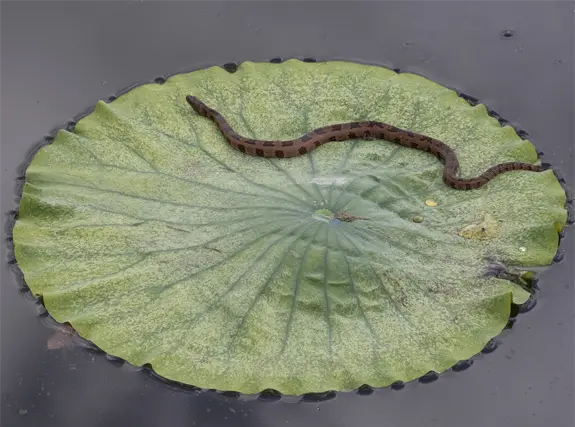
Photo 136051133 © b_taylor, CC BY-NC

Common Health Risks
Brown water snakes help control rodent, mosquito, and pest populations as non-venomous predators. They present minimal risk to humans if left undisturbed:
- Bites – Uncommon and not medically significant. Their rear teeth can inflict shallow lacerations if handled roughly.
- Diseases – Brown water snakes are not known to transmit any contagious diseases. Practice basic hygiene precautions if bitten.
- Defensive musking – Brown water snakes release a foul musk from their cloaca when threatened. This can cause minor skin and eye irritation.
The biggest risk is mistaken identity with venomous cottonmouths which share aquatic habitats. Bites from aggravated cottonmouths can be medically significant. It is important to correctly identify any snakes on your property and avoid approaching or handling them. Notify animal control if any venomous snakes are confirmed near homes.
Preventing Coral Snake Encounters
Brown water snakes naturally avoid developed areas and interactions with humans if possible. Follow these tips to discourage brown water snakes near homes:
- Remove habitat covers – Keep shorelines clear of debris and dense vegetation that provides hiding spots.
- Limit food sources – Enclose compost piles. Don’t leave pet food outside.
- Install barriers – Fence off wetlands and ponds with at least a 3 foot buffer zone from the house.
- Seal access points – Repair cracks in foundations and openings where pipes enter homes.
- Use snake deterrents – Strategically place moth balls, sulfur powder, or predator urine granules.
- Modify landscaping – Position flowering plants that attract bees away from the home. Remove birdhouses near doors.
Notify a professional if any venomous cottonmouths are observed on a property. Otherwise, brown water snakes encountered near homes can be safely removed or encouraged to leave by gently spraying them with a garden hose.
Brown Water Snakes in Central Florida – Conclusion
Brown water snakes are common non-venomous serpents that inhabit central Florida’s plentiful wetlands and waterways. They help control pest populations and present very low risk to humans if undisturbed. Basic exclusion methods and removing habitat covers can discourage brown water snakes from approaching homes and developed areas.
Their presence indicates a healthy aquatic ecosystem, providing a natural form of mosquito and rodent control. With proper identification and avoidance, brown water snakes pose no threat and can be appreciated for their important ecological roles.

